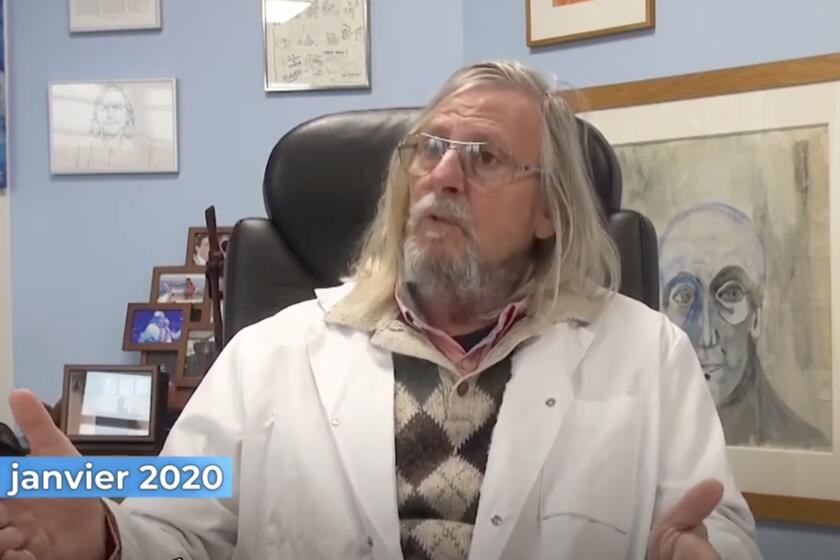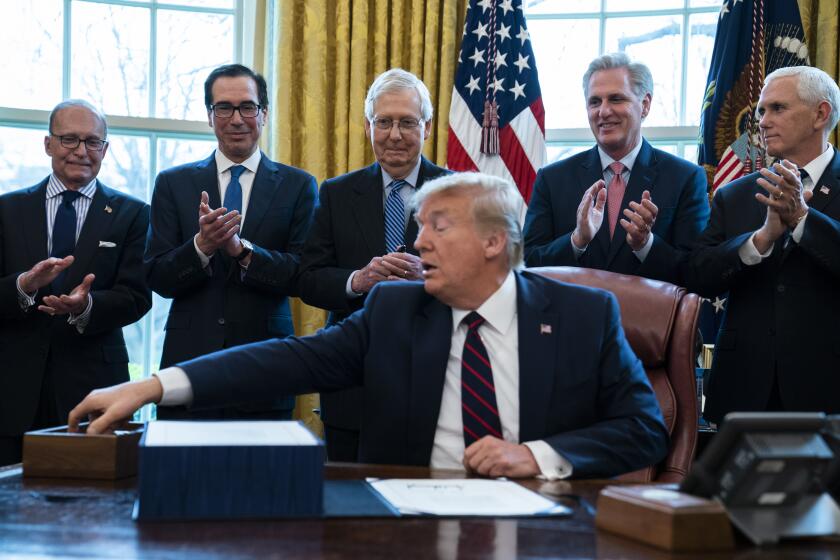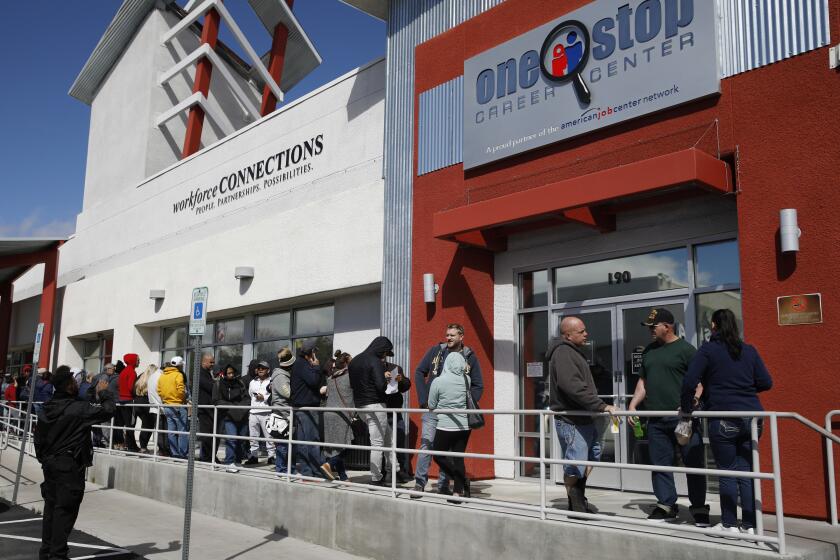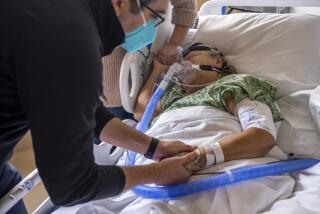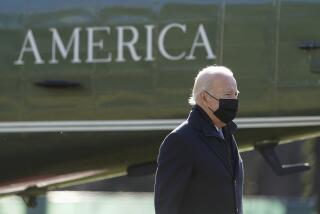Column: The coronavirus can be crushed in 10 weeks — if we do all these things right
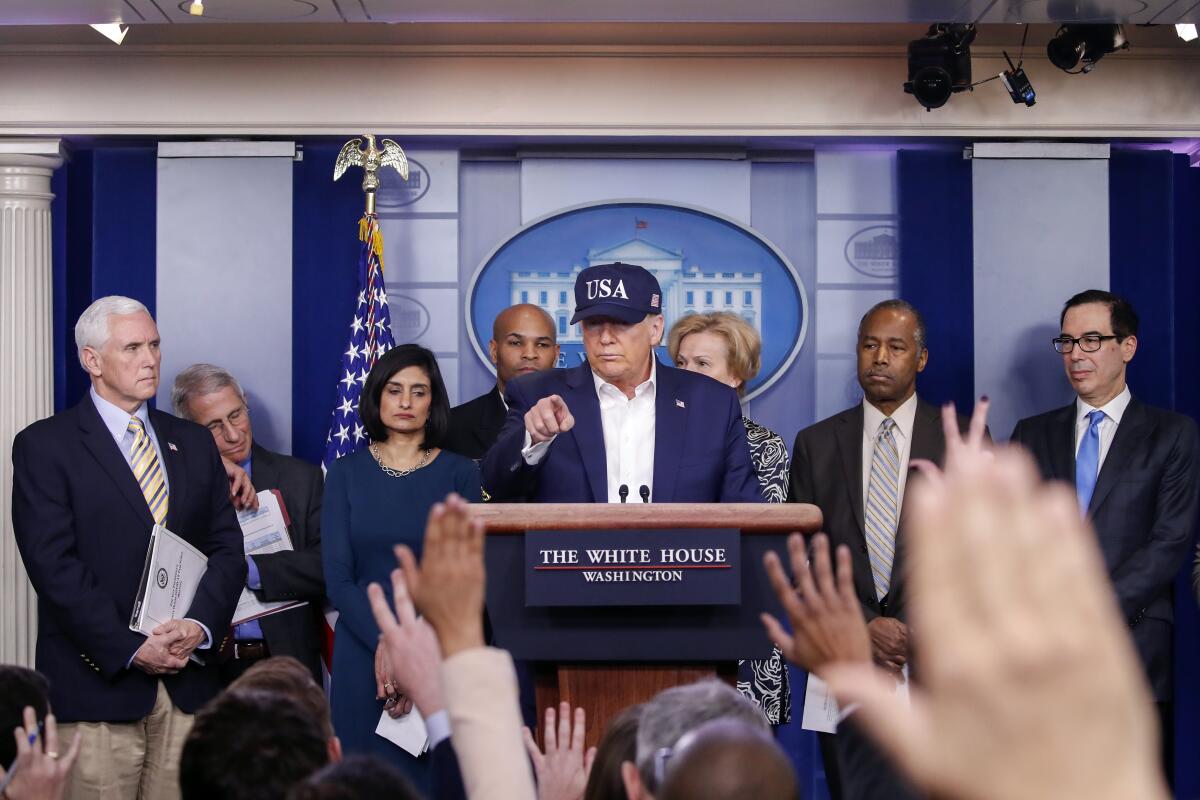
President Trump describes the coronavirus crisis as a war and labels himself a “wartime president.”
What’s lacking in Washington and many parts of the country, however, is a home-front strategy aimed at winning the war. That’s the view of Harvey V. Fineberg, a former president of the Institute of Medicine (now the National Academy of Medicine) and dean of the Harvard T.H. Chan School of Public Health who is now president of the Palo Alto, Calif.-based Gordon and Betty Moore Foundation.
In a recent essay for the New England Journal of Medicine, Fineberg mapped out a strategy that could defeat the novel coronavirus and lead to a reopening of the U.S. economy in 10 weeks — that is, by early June.
All the things we’re talking about would have clear lines of responsibility, timeline of execution and you’d get the job done as you would in a real war.
— Dr. Harvey Fineberg
Fineberg’s ideas aren’t simple shortcuts. They require strong leadership and public sacrifice.
“The aim is not to flatten the curve,” he wrote, referring to the process of stemming the exponential growth of infections to avert a surge that overwhelms America’s hospitals. “The goal is to crush the curve,” as China did by imposing a draconian shutdown in Wuhan, the epicenter of its coronavirus emergency.
“Most analyses of options and trade-offs assume that both the pandemic and the economic setback must play out over a period of many months for the pandemic and even longer for economic recovery,” Fineberg wrote. Instead, he proposes an option that “simultaneously limits fatalities and gets the economy cranking again in a sustainable way. That choice begins with a forceful, focused campaign to eradicate COVID-19 in the United States.”
Fineberg’s specific prescriptions are both uplifting and dispiriting. Uplifting because every element is at least theoretically within America’s capabilities, though some would be easier to implement than others, in part because they require strong, consistent national leadership. Dispiriting because we’ve made almost no nationwide progress on any of them, and some seem well shy of the agenda of the Trump administration.
Without minimizing the scale of the economic plunge, it’s proper to place comparisons between today’s figures and economic situation and those of the Depression in perspective. In short: The differences are greater than the similarities.
That’s certainly true of his Step 1: “Establish unified command.”
Fineberg isn’t talking about an interagency coordinator, but a commander with the authority to “mobilize every civilian and military asset needed to win the war.” This individual must not only channel presidential authority, but muster the confidence of the American public for the task.
“All the things we’re talking about would have clear lines of responsibility, timeline of execution and you’d get the job done as you would in a real war,” Fineberg told me.
“Even Lincoln had to find his Gen. Grant before he could win the Civil War,” Fineberg says. “I think the president would surprise his critics if he took this step. It’s still timely.”
(Historical note: Lincoln didn’t appoint Ulysses S. Grant to command the Union Army until March 1864, three years after the war began. Grant brought the war to an end just over one year later.)
Unfortunately, Trump is moving in the opposite direction. His management approach to the coronavirus crisis is to invest several officials with responsibility, serially and sometimes all at once. The job of managing the virus response has been held successively by Health and Human Services Secretary Alex Azar, Vice President Mike Pence and Trump’s son-in-law Jared Kushner.
But turf battles have been raging. Over the weekend, Trump trade advisor Peter Navarro reportedly confronted infectious disease expert Anthony Fauci over the latter’s warnings that there is no scientific support for the efficacy of Trump’s favorite virus remedy, chloroquine.
This battle between Navarro’s total lack of expertise and Fauci’s decades of experience underscores the diffusion of authority at the top of the federal government.
President Trump’s hype of a potential treatment for COVID-19 gives false hope to virus patients and causes real harm to others.
Several of Fineberg’s suggestions correspond to the well-understood imperatives for dealing with any pandemic, but underscore the specific failings of the U.S. response.
“The nation needs to gear up to perform millions of diagnostic tests” by the middle of this month, he advised, with testing of everyone with symptoms. “Without diagnostic tests, we cannot trace the scope of the outbreak.”
If the U.S. reaches that goal, it will be by only a hair. The White House asserted that about 1.8 million tests had been performed by Monday, with about 100,000 more being done each day. But on a per-capita basis, that’s still well behind South Korea and Germany, which have had far more success tracking the outbreak.
Fineberg also points to the necessity of preparing hospitals for a surge in severely ill patients and providing ample supplies of personal protective equipment for every health worker “caring for patients and testing for infection. ... We wouldn’t send soldiers into battle without ballistic vests; health workers on the front lines of this war deserve no less.”
The spectacle of healthcare workers gowned in repurposed plastic trash bags and instructed about how to sterilize single-use masks for reuse all but defines the collapse of America’s healthcare infrastructure in the face of COVID-19.
A report just issued by the inspector general of Health and Human Services documented the scale of this failure. It cited hospitals’ complaints of severe shortages of testing supplies, long waits for results, widespread shortages of protective equipment and blockages in the supply chains for replenishment, and conflicting guidance from government agencies on which elective procedures to delay, use of PPE and getting supplies from the national stockpile.
Typically, Trump dismissed the report, asserting untruthfully that it was prepared by Obama appointees; in fact the report was supervised by a career official who has worked for the government through two Democratic and two Republican administrations, including Trump’s.
Trump says he won’t cooperate with bailout oversight, so what is he hiding?
Fineberg’s most complicated suggestion is to differentiate the population into five groups and treat them accordingly: those known to be infected, those presumed infected (i.e., with symptoms but negative tests), those who have been exposed, those not known to have been exposed or infected, and those who have recovered and therefore are presumed to be immune.
Among the first four groups, those with severe disease or who are at high risk should be hospitalized. Low-risk patients or those with mild forms of the disease should be cared for in infirmaries in empty conventions centers or other sequestered locations, so they can’t infect family members. Others who have been exposed should be quarantined in special centers for 14 days.
That would allow for a staged process of reopening the economy. “If we implement radical testing strategies,” Fineberg told me, “we will, for example, know who has had the infection and now has antibodies.
“We don’t know for sure how large the group of asymptomatics are, but it’s possible that we could try in selected and controlled ways to get things moving again in select communities if we do it intelligently,” remaining on the lookout for any recurrence of the infection and being ready to damp down at a moment’s notice when it looks like it could reoccur.
It’s time to think about how to get workers raises over the long term.
Fineberg’s approach resembles one being proposed by other experts. Former Food and Drug Administration commissioners Scott Gottlieb and Mark McClennan, who both served under Republican presidents — Trump and George W. Bush, respectively — have offered a plan for gradual reopening of the economy by creating a regime of thorough testing and disease surveillance.
“There is no time to lose,” they wrote, according to Politico. “Building these capabilities now will accelerate our ability to assure the public’s safety — the foundation for a sustainable and secure approach to reopening our communities.”
Any such intrusive system would require credible leadership to “inspire and mobilize the public,” Fineberg wrote. That leadership has emerged in some states and communities — “we’re getting it from [California Gov. Gavin] Newsom, [New York Gov. Andrew] Cuomo, and Mayor London Breed here in San Francisco,” he told me. But not from Trump.
“If you listen to the president, he sounds ambivalent,” Fineberg says. “On the one hand, he is clearly accepting the severity of the threat, and speaks to the public very soberly. Yet in the same hour he will revert to this notion that ‘you can’t let the cure be worse than the disease.’
“He’s expressing the duality all of us feel: We want to get the economy working and we want to get rid of this virus. The case I’m making is that it’s not a choice of one or the other. It’s about a smart strategy to get us through both fronts of this war, the economic front and the biologic front.”
More to Read
Inside the business of entertainment
The Wide Shot brings you news, analysis and insights on everything from streaming wars to production — and what it all means for the future.
You may occasionally receive promotional content from the Los Angeles Times.

